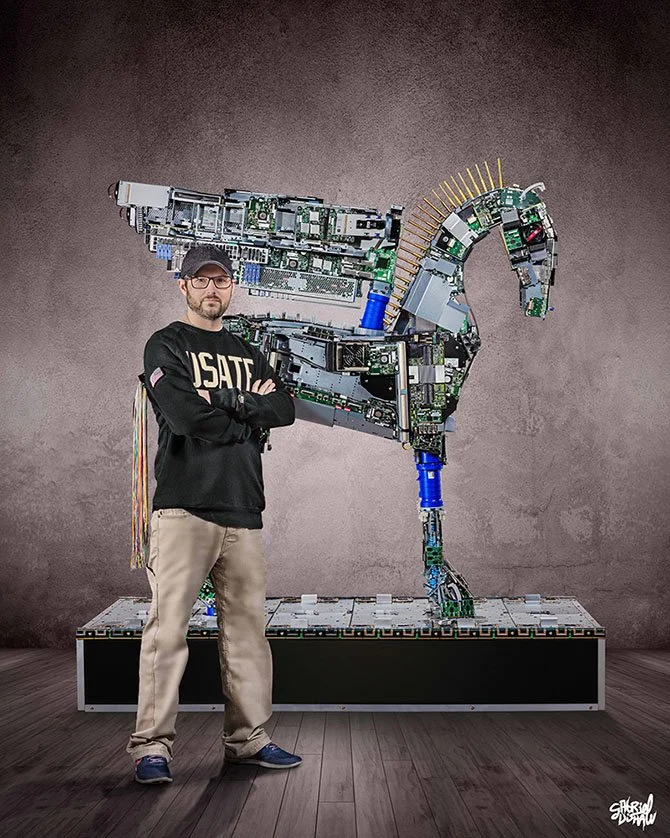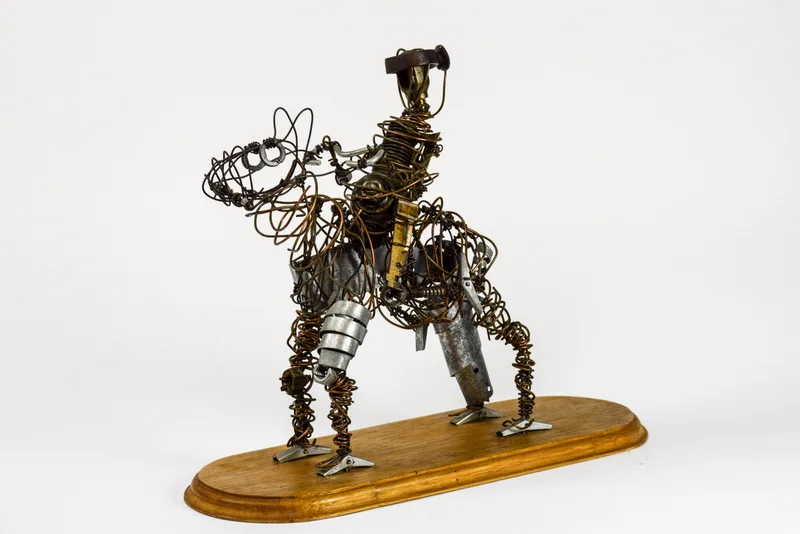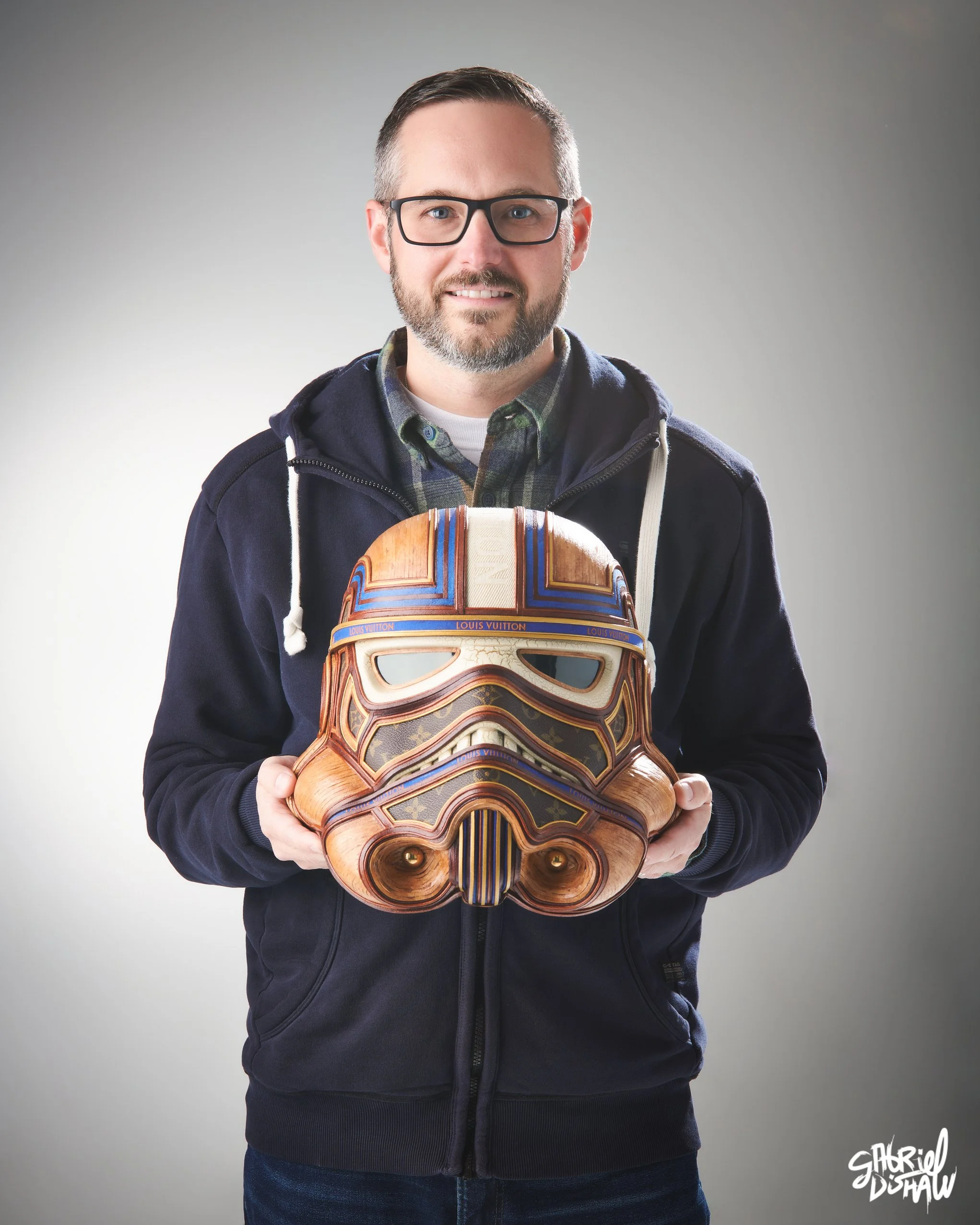Who is Gabriel Dishaw
Gabriel Dishaw is a Sculptor / Upcycler based in Indianapolis, Indiana. Gabriel creates unique sculptures using upcycled materials from luxury brands such as Louis Vuitton, Gucci, and discarded electronic components and other found objects. He was born in 1980 and has been creating for 25-plus years.
Dishaw's work explores themes such as the intersection of high fashion, pop culture, technology, and sustainability through various forms of upcycling. His series range from Louis Vuitton-inspired Stormtroopers and Mortal Kombat Masks to Gucci-embellished Pokemon and Mythical creatures reimagined through discarded E-waste. His art has been exhibited in numerous galleries and museums throughout the United States.
Gabriel’s work has two distinct approaches/series
Both approaches are based on a foundation of upcycling or repurposing materials but prioritize certain features.
Luxury Series - In this series, he explores the intersection of fashion and pop culture, using upcycled luxury goods, leather, and hardware to achieve an elevated look, paying special attention to craftsmanship synonymous with luxury. This is all to express his love and admiration of these iconic pop-related artifacts and to bring attention to their contribution to our culture.
Examples of this approach:
E-waste / Upcycling Series - In this series, he lean more heavily into upcycling with the materials or found objects to drive the approach. This produces a looser feel that allows for the sum of the materials to form a new object. As you draw closer to the sculpture, you pick up on the details and objects used taking you on another journey of discovery to identify the individual pieces that make up the sculpture.
Examples of this approach:
Gabriel’s Artist Statement
My passion for working with metal and mechanical objects has been essential in the evolution of my art. It provides me an avenue to express myself in a way that brings new life to materials such as typewriters, adding machines and old computers – technology that would normally end up in a landfill. My mission is to create dialogue and help find creative, environmentally sound ways of re-purposing e-waste.
When did you first discover your passion for upcycling?
I’ve always been an artistic individual and was enrolled in advanced art classes in school, but I truly found my passion for this particular art form in 9th Grade. My teacher posted 30 art project ideas on the chalk board for us to choose from and make it our own. One of the items listed was “Junk Art.” To be honest, I had no idea what that was so I did a bit of research then went into my dad’s garage and began to tinker. That’s one of those moments you look back on and think had the art teacher not offered that particular project, I don’t know I would have emerged an artist in this genre. Click here for more details.
What was your first project?
My first piece was an abstract sculpture – which I still have to this day – titled “Mary on a Donkey.” I created it for the local DOW Chemical Holiday Art Show in high school. To my surprise it took the top honors in the 3D art category. I plan to keep it as a reminder of my humble beginnings as an upcycler and sculptor.
Mary on a Donkey
How did you learn your craft?
Early on, it was something I worked on sporadically. However, in college I studied 2D and 3D art as well as figurative drawing as part of my curriculum. This helped to provide a solid knowledge base when creating the supporting structures underneath the art. I also began to acquire material from people I knew at that time, which generally consisted of discarded technology from the 60s and 70s. It’s been a progressive process getting familiar with the craft and establishing my own signature edge. I started with small scale figures and then later moved on to larger projects as I worked through the learning curve.
What are some of your favorite materials to work with?
I find adding machines and typewriters to be the most useful when sourcing parts for projects. They have similar elements such as striker keys and gears in duplicate quantities, which makes it easier to create symmetrical designs. Beyond that, I often go to antique shops looking for unique items – something no one in their right mind would buy. As the saying goes, “One man’s trash is another man’s treasure.”
What is the story behind your artwork series?
Each series represents a personal interest or passion of mine. For instance the sneakers series – I have a sneaker collection in excess of 380 pairs. That bleeds over to my artwork which consists of the shoes I like the most. My love of sci-fi and all things “Star Wars” has significantly influenced my creature and figurative sculptures. I’m constantly looking for new ways to use old materials, showcasing them in a new light that is of interest to me. In that respect one sculpture can easily balloon into a series.
What is the story behind your Luxury Series?
For Gabriel Dishaw, it’s always been about the journey. For him, the creative process starts with disassembling items and then reimaging them as new objects. Through his work, he is also able to express his eagerness to inspire dialogue on reducing waste and participate in creative solutions for utilizing materials that would often be discarded after its intended use and repurposes them so others can find enjoyment.
His Luxury Series builds upon this philosophy. With each piece, Gabriel has taken characters and universes from his childhood as well as his passion for science fiction and elevated them from their original meanings and stories by using textiles from luxurious brands. Whether based on a toy he grew up with or a film he’s rewatched countless times, each piece reflects a moment in time through a modern, fashionable twist.
Where do you draw inspiration? What’s your process?
Generally I begin a project without any defined plan. Instead, I look for how well pieces work together or how they move and then let those materials drive the color scheme or overall endpoint of where an idea will land, what it will turn into. For instance, the inspiration for one of my horse sculptures, “Rearing Horse,” came to me while taking apart an old adding machine. Some of the pieces reminded me of a horse’s head. The rest just fell into place. For a commissioned pieces, it’s a bit of a different story. The theme is very much inspired by the client, their history and the story to be told through my art.
How long does it take you to create a piece of art – start to finish?
Much of that depends on the scale and complexity of the sculpture – and a bit of luck finding the right pieces to the puzzle. Some of my smaller projects can take approximately 40 hours to complete, however, I might have spent several hours simply digging through my bins to locate the hundreds of parts needed to construct it. I pride myself in adding hidden details to each art piece which takes time and is not easily translated through pictures.
What direction do you see your work going in the future?
I see it growing in a couple different directions: shoe sculptures that are so refined you’ll think they’re real and an extended “Darth Vadar” collection that pushes the envelope a bit. Both of those categories are pretty well-defined in terms of my artistic spin on them, so regarding long-term strategy it only makes sense to think about other bases beyond my core audience. Stay tuned.
How do you package and ship your sculptures to ensure safe travels and premium experience?
“The video below provides insight into the unboxing experience and why it’s so important. ”





